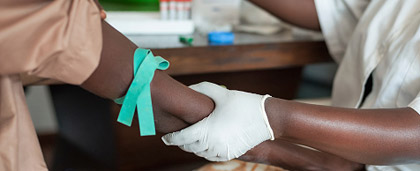Ebola Basics
Origins

Ebola viruses are found in several African countries. Ebola was first discovered in 1976 near the Ebola River in what is now the Democratic Republic of the Congo. Since then, outbreaks of Ebola among humans have appeared sporadically in Africa.
The Spread of the Disease
Ebola has spread rapidly in West Africa due to the absence of fundamental public health infrastructures. This outbreak demonstrates how a deadly pathogen can exploit any weakness in the health infrastructure, whether it be inadequate numbers of health care providers or the virtual absence of isolation wards and intensive care facilities throughout much of sub-Saharan Africa. As the disease is largely concentrated in the some of the world’s most impoverished countries, the Ebola outbreak spotlights the dangers of the world’s growing social and economic inequalities.
Transmission & Diagnosis
Ebola is transmitted via blood or body fluids (including but not limited to urine, saliva, sweat, feces, vomit, breast milk, and semen) of a person who is sick with Ebola; objects (like needles and syringes) that have been contaminated with the virus; or infected fruit bats or primates (apes and monkeys.) Ebola is not spread through the air, by water, or in general, by food.
Diagnosing Ebola in a person who has been infected for only a few days is difficult.
Early symptoms, such as fever, are nonspecific to Ebola infection and often are seen in patients with more common diseases, such as malaria and typhoid fever. CDC and other organizations are also deploying teams of public health experts to contain the spread of the virus in West Africa and other affected countries. CDC and its domestic partners are taking precautions to prevent the further spread of Ebola within the United States.
Treatment
Individuals exhibiting symptoms of Ebola should be isolated and public health professionals notified, so that proper
treatment protocols can be implemented. Blood samples from the patient can then be collected and tested to confirm infection. Although Ebola emerged nearly 40 years ago, there is currently no vaccine or cure. In response to the current crisis, the World Health Organization predicts that two vaccines may be ready for introduction by the end of 2014. Five to ten other Ebola drugs are in the development pipeline.
Travel Precautions
CDC has staff working 24/7 at 20 Border Health field offices located in international airports and land borders. On October 27, CDC’s public health authorities began active post-arrival monitoring of travelers whose travel originates in Liberia, Sierra Leone, or Guinea. In addition, the Department of Homeland Security in October imposed
new travel restrictions for anyone arriving from Liberia, Sierra Leone and Guinea, requiring those passengers to come through one of five major U.S. airports in Atlanta, Chicago, New Jersey, New York and Virginia.
The CDC urges all US residents to avoid nonessential travel to Guinea, Liberia, and Sierra Leone because of outbreaks of Ebola in those countries. The CDC recommends that travelers to these countries protect themselves by avoiding contact with the blood and body fluids of people who are sick with Ebola.
International Response
Several organizations are involved in helping to contain the spread of the disease in Africa and providing medical care to those who contract the disease. Three of the most involved groups are the
U.S. Centers for Disease Control and Prevention, World Health Organization, and Doctors Without Borders. In addition, President Obama has requested $6.2 billion in emergency funding from the U.S. Congress to assist the most affected countries in fighting the spread of the disease.
Sources: Centers for Disease Control and Prevention, Washington Post, World Health Organization
Last updated 11.13.14